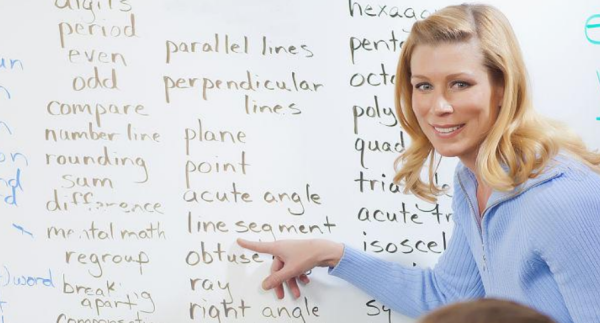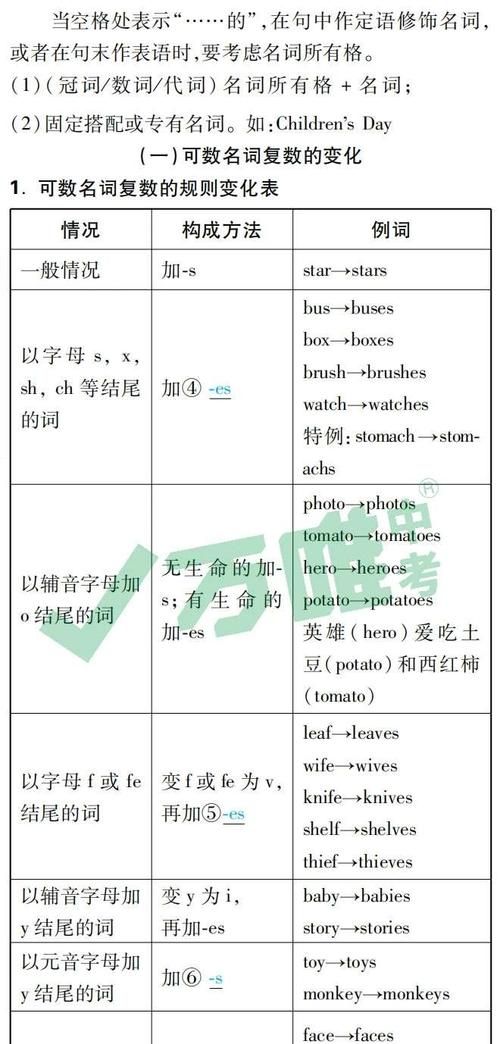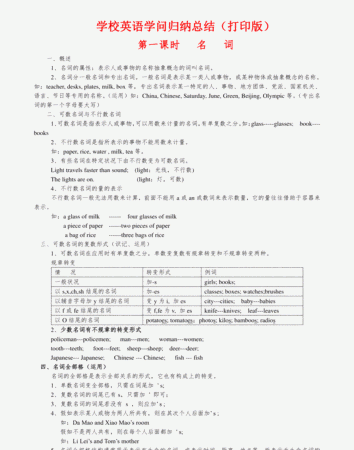本文目录
英语名词知识点归纳思维导图
英语名词知识点归纳如下:
名词的定义:名词名词 (Nouns)是词性的一种,也是实词的一种,是指待人、物、事、时、地、情感、概念等实体或抽象事物的词。名词可以独立成句。在短语或句子中通常可以用代词来替代。
专有名词:指表示人、地方、机构、组织等的专有名称。具体说来,它包括人名、地名、月份、星期、节日、书名、电影名以及某些抽象名词等。
如:Jim 吉姆、China 中国、Mr. Smith 史密斯先生、July 七月、Friday 星期五、the Yellow River 黄河、 English 英语、A Tale of Two Cities 《双城记》。

注意事项:
专有名词的首字母通常要大写。若是专名名词词组,则其中每个单词的首字母要大写;若是缩略词,则通常每个字母都大写;称呼家人的 mum, dad, father, mother 等有时也可小写。
英语名词知识点归纳思维导图
英语名词知识点归纳有:
1、专有名词是某个(些)人,地方,机构等专有的名称,如Beijing,China等。
2、普通名词是一类人或东西或是一个抽象概念的名词,如:book,sadness等。
3、集体名词表示若干个个体组成的集合体,如:family。

4、物质名词表示无法分为个体的实物,如:air。
5、抽象名词表示动作、状态、品质、感情等抽象概念,如:work。
6、从可数和不可数来看,个体名词可以用数目来计算,称为可数名词(Countable Nouns)。物质名词、抽象名词和专有名词无法用数目来计算,称为不可数名词(Uncountable Nouns)。
中考英语名词有哪些知识点及答案
A)、名词的数 我们知道名词可以分为可数名词和不可数名词,而不可数名词它没有复数形式,但可数名词却有单数和复数之分,复数的构成如下: 一)在后面加s。如:fathers, books, Americans, Germans, apples, bananas 二)x, sh, ch, s, tch后加es。如:boxes, glasses, dresses, watches, wishes, faxes 三)1)以辅音字母加y结尾的变y为i再加es 如:baby-babies, family-families, duty-duties, comedy-comedies, documentary-documentaries, story-stories 2)以元音字母加y结尾的直接加s。如:day-days, boy-boys, toy-toys, key-keys, ways 四)以o结尾加s(外来词)。如:radios, photos, 但如是辅音加o的加es:如: tomatoes西红柿, potatoes马铃薯 五)以f或fe结尾的变f为v再加es(s)。如:knife-knives, wife-wives, half-halves, shelf-shelves, leaf-leaves, yourself-yourselves 六)单复数相同(不变的)有:fish, sheep, deer鹿子, Chinese, Japanese 七)一般只有复数,没有单数的有:people,pants, shorts, shoes, glasses, gloves, clothes, socks 八)单词形式不变,既可以是单数也可以是复数的有:police警察局,警察, class班,同学, family家,家庭成员 九)合成的复数一般只加主要名词,多数为后一个单词。如:action movie-action movies, pen pal-pen pals; 但如果是由man或woman所组成的合成词的复数则同时为复数。如:man doctor-men doctors, woman teacher-women teachers 十)有的单复数意思不同。如:fish鱼 fishes鱼的种类, paper纸 papers报纸,卷子,论文, work工作 works作品,工厂, glass玻璃 glasses玻璃杯,眼镜, orange桔子水 oranges橙子, light光线 lights灯, people人 peoples民族, time时间 times时代, 次数, chicken 鸡肉 chickens 小鸡 十一) 单个字母的复数可以有两种形式直接加s或’s。如:Is (I’s), Ks (K’s)。但如是缩略词则只加s。如:IDs, VCDs, SARs 十二) 特殊形式的有:child-children, man-men, woman-women, foot-feet, mouse-mice, policeman-policemen, Englishman-Englishmen B)名词的格 当我们要表示某人的什么东西或人时,我们就要使用所有格形式。构成如下: 一)单数在后面加’s。如:brother’s, Mike’s, teacher’s 二)复数以s结尾的直接在s后加’,如果不是以s结尾的与单数一样处理。如:Teachers’ Day教师节, classmates’; Children’s Day六一节, Women’s Day三八节 三)由and并列的名词所有时,如果是共同所有同一人或物时,只加最后一个’s,但分别拥有时却分别按单数形式处理。如:Mike and Ben’s room迈克和本的房间(共住一间),Mike’s and Ben’s rooms迈克和本的房间(各自的房间) 2、代词 项目 人称代词 物主代词 指示代词 反身代词 人称 主格 宾格 形容词 名词性 第一人称 单数 I me my mine myself 复数 we us our ours ourselves 第二人称 单数 you you your yours yourself 复数 you you your yours yourselves 第三人称 单数 she her her hers herself he him his his himself it it its its this that itself 复数 they them their theirs these those themselves 3、动词 A) 第三人称单数 当动词是第三人称单数时,动词应该像名词的单数变动词那样加s,如下: 一)一般在词后加s。如:comes, spells, waits, talks, sees, dances, trains 二)在x, sh, ch, s, tch后加es。如:watches, washes, wishes, finishes 三)1)以辅音字母加y结尾的变y为i再加es。如:study-studies, hurry-hurries, try-tries 2)以元音字母加y结尾的直接加s。如:plays, says, stays, enjoys, buys 四)以o结尾加es。如:does, goes 五)特殊的有:are-is, have-has B) 现在分词 当我们说某人正在做什么事时,动词要使用分词形式,不能用原形,构成如下: 一)一般在后加ing。如:spell-spelling, sing-singing, see-seeing, train-training, play-playing, hurry-hurrying, watch-watching, go-going, do-doing 二)以不发音e的结尾的去掉e再加ing。如:dance-dancing, wake-waking, take-taking, practice-practicing, write-writing, have-having 三)以重读闭音节结尾且一个元音字母+一个辅音字母(注意除开字母组合如show –showing, draw-drawing)要双写最后的辅音字母再加ing。如:put-putting, run-running, get-getting, let-letting, begin-beginning 四)以ie结尾的变ie为y再加ing。如:tie-tying系 die-dying死 lie-lying 位于 4、形容词的级 我们在对两个或以上的人或物进行对比时,则要使用比较或最高级形式。构成如下: 一) 一般在词后加er或est(如果是以e结尾则直接加r或st)。如:greater-greatest, shorter –shortest, taller –tallest, longer –longest, nicer- nicest, larger -largest 二)以重读闭音节结尾且1个元音字母+1个辅音字母(字母组合除外,如few-fewer fewest)结尾的双写结尾的辅音再加er /est。如:big-bigger biggest, red-redder reddest, hot-hotter hottest 三) 以辅音字母+y结尾的变y为i加er/est。如:happy-happier happiest, sorry-sorrier sorriest, friendly-friendlier friendliest(more friendly most friendly), busy-busier busiest, easy-easier easiest 四)特殊情况:(两好多坏,一少老远) good/well - better best many/much - more most bad/ill – worse worst little- less least old- older/elder oldest/eldest far- farther/further farthest/furthest 5、数词 (基变序,有规则;一、二、三,自己背;五、八、九、十二;其它后接th;y结尾,变为i, eth跟上去。) first, second, third; fifth, eighth, ninth, twelfth; seventh, tenth, thirteenth, hundredth; twenty-twentieth, forty-fortieth, ninety-ninetieth 二、句式 1. ⑤ 问原因 Why do you want to join the club? ⑥ 问时间 What’s the time? (=What time is it?) It’s a quarter to ten a.m.. What time do you usually get up, Rick? At five o’clock. When do you want to go? Let’s go at 7:00. ⑦ 问地方 Where’s my backpack? It’s under the table. ⑧ 问颜色 What color are they? They are light blue. What’s your favourite color? It’s black. ⑨ 问人物 Who’s that? It’s my sister. Who is the boy in blue? My brother. Who isn’t at school? Peter and Emma. Who are Lisa and Tim talking to? ⑩ 问东西 What’s this/that (in English)? It’s a pencil case. What else can you see in the picture? I can see some broccoli, strawberries and hamburgers. 11问姓名 What’s your aunt’s name? Her name is Helen./She’s Helen. What’s your first name? My first name’s Ben. What’s your family name? My family name’s Smith. 12 问哪一个 Which do you like? I like one in the box. 13 问字母 What letter is it? It’s big D/small f. 14 问价格 How much are these pants? They’re 15 dollars. 15 问电话号码 What’s your phone number? It’s 576-8349. 16 问谓语(动作) What’s he doing? He’s watching TV. 17 问职业(身份) What do you do? I’m a teacher. What’s your father? He’s a doctor. 三、时态 1、一般现在时 表示普遍、经常性的或长期性的动作时使用一般现在时,它有: Be 动词:She’s a worker. Is she a worker? She isn’t a worker. 情态动词:I can play the piano. Can you play the piano? I can’t play the piano. 行为动词:They want to eat some tomatoes. Do they want to eat any tomatoes? They don’t want to eat any tomatoes. Gina has a nice watch. Does Gina have a nice watch? Gina doesn’t have a watch. 2、现在进行时 表示动词在此时正在发生或进行就使用进行时态,结构为sb be v-ing sth + 其它. They’re listening to the pop music. Are they listening the pop music? They aren’t listening to the pop music. A)、名词的数 我们知道名词可以分为可数名词和不可数名词,而不可数名词它没有复数形式,但可数名词却有单数和复数之分,复数的构成如下: 一)在后面加s。如:fathers, books, Americans, Germans, apples, bananas 二)x, sh, ch, s, tch后加es。如:boxes, glasses, dresses, watches, wishes, faxes 三)1)以辅音字母加y结尾的变y为i再加es 如:baby-babies, family-families, duty-duties, comedy-comedies, documentary-documentaries, story-stories 2)以元音字母加y结尾的直接加s。如:day-days, boy-boys, toy-toys, key-keys, ways 四)以o结尾加s(外来词)。如:radios, photos, 但如是辅音加o的加es:如: tomatoes西红柿, potatoes马铃薯 五)以f或fe结尾的变f为v再加es(s)。如:knife-knives, wife-wives, half-halves, shelf-shelves, leaf-leaves, yourself-yourselves 六)单复数相同(不变的)有:fish, sheep, deer鹿子, Chinese, Japanese 七)一般只有复数,没有单数的有:people,pants, shorts, shoes, glasses, gloves, clothes, socks 八)单词形式不变,既可以是单数也可以是复数的有:police警察局,警察, class班,同学, family家,家庭成员 九)合成的复数一般只加主要名词,多数为后一个单词。如:action movie-action movies, pen pal-pen pals; 但如果是由man或woman所组成的合成词的复数则同时为复数。如:man doctor-men doctors, woman teacher-women teachers 十)有的单复数意思不同。如:fish鱼 fishes鱼的种类, paper纸 papers报纸,卷子,论文, work工作 works作品,工厂, glass玻璃 glasses玻璃杯,眼镜, orange桔子水 oranges橙子, light光线 lights灯, people人 peoples民族, time时间 times时代, 次数, chicken 鸡肉 chickens 小鸡 十一) 单个字母的复数可以有两种形式直接加s或’s。如:Is (I’s), Ks (K’s)。但如是缩略词则只加s。如:IDs, VCDs, SARs 十二) 特殊形式的有:child-children, man-men, woman-women, foot-feet, mouse-mice, policeman-policemen, Englishman-Englishmen B)名词的格 当我们要表示某人的什么东西或人时,我们就要使用所有格形式。构成如下: 一)单数在后面加’s。如:brother’s, Mike’s, teacher’s 二)复数以s结尾的直接在s后加’,如果不是以s结尾的与单数一样处理。如:Teachers’ Day教师节, classmates’; Children’s Day六一节, Women’s Day三八节 三)由and并列的名词所有时,如果是共同所有同一人或物时,只加最后一个’s, I’m playing baseball. Are you playing baseball? I’m not playing baseball. Nancy is writing a letter. Is Nancy writing a letter? Nancy isn’t writing a letter. They’re listening to the pop music. Are they listening the pop music? They aren’t listening to the pop music.

初中英语名词语法知识点
名词的用法
名词可以分为专有名词和普通名词,专有名词是某个(些)人,地方,机构等专有的名称,如Beijing,China等。普通名词是一类人或东西或是一个抽象概念的名词,如:book,sadness等。普通名词又可分为下面四类:
1)个体名词:表示某类人或东西中的个体,如:gun。
2)集体名词:表示若干个个体组成的集合体,如:family。
3)物质名词:表示无法分为个体的实物,如:air。
4)抽象名词:表示动作、状态、品质、感情等抽象概念,如:work。
个体名词和集体名词可以用数目来计算,称为可数名词,物质名词和抽象名词一般无法用数目计算,称为不可数名词。归纳一下,名词的分类可以下图表示:
名词 专有名词 不可数名词
普通名词 物质名词
抽象名词
集体名词
可数名词
个体名词
1.1 名词复数的规则变化
情况 构成方法 读音 例词
一般情况 加 -s 清辅音后读/s/ map-maps
浊辅音和元音后读 /z/ bag-bags /car-cars
以s, sh, ch, x等结尾 加 -es 读 /iz/ bus-buses/ watch-watches
以ce, se, ze,等结尾 加 -s 读 /iz/ license-licenses
以辅音字母+y结尾 变y 为i再加es 读 /z/ baby---babies
1.2 其它名词复数的规则变化
1) 以y结尾的专有名词,或元音字母+y 结尾的名词变复数时,直接加s变复数。例如:
two Marys the Henrys
monkey---monkeys holiday---holidays
2) 以o 结尾的名词,变复数时:
a. 加s,如: photo---photos piano---pianos
radio---radios zoo---zoos;
b. 加es,如:potato--potatoes tomato--tomatoes
c. 上述a和b两种方法均可,如zero---zeros / zeroes。
3) 以f或fe 结尾的名词变复数时:
a. 加s,如: belief---beliefs roof---roofs
safe---safes gulf---gulfs;
b. 去f,fe 加ves,如:half---halves
knife---knives leaf---leaves wolf---wolves
wife---wives life---lives thief---thieves;
c. 上述a和b两种方法均可,如handkerchief: handkerchiefs / handkerchieves。
1.3 名词复数的不规则变化
1) child---children foot---feet tooth---teeth
mouse---mice man---men woman---women
注意:由一个词加 man 或 woman构成的合成词,其复数形式也是 -men 和-women,如an Englishman,two Englishmen。但German不是合成词,故复数形式为Germans;Bowman是姓,其复数是the Bowmans。
2) 单复同形,如deer,sheep,fish,Chinese,Japanese ,li,jin,yuan,two li,three mu,four jin等。但除人民币的元、角、分外,美元、英镑、法郎等都有复数形式。如:a dollar, two dollars; a meter, two meters。
3)集体名词,以单数形式出现,但实为复数。例如:
people police cattle 等本身就是复数,不能说 a people,a police,a cattle,但可以说a person,a policeman,a head of cattle, the English,the British,the French,the Chinese,the Japanese,the Swiss 等名词,表示国民总称时,作复数用,如The Chinese are industries and brave. 中国人民是勤劳勇敢的。
4) 以s结尾,仍为单数的名词,如:
a. maths,politics,physics等学科名词,一般是不可数名词,为单数。
b. news 为不可数名词。
c. the United States,the United Nations 应视为单数。
The United Nations was organized in 1945. 联合国是1945年组建起来的。
d. 以复数形式出现的书名,剧名,报纸,杂志名,也可视为单数。例如:
"The Arabian Nights" is a very interesting story-book. 《一千零一夜》是一本非常有趣的故事书。
5) 表示由两部分构成的东西,如:glasses (眼镜) trousers, clothes等,若表达具体数目,要借助数量词 pair(对,双); suit(套); a pair of glasses; two pairs of trousers等。
6) 另外还有一些名词,其复数形式有时可表示特别意思,如:goods货物,waters水域,fishes(各种)鱼。
1.4 不可数名词量的表示
1)物质名词
a. 当物质名词转化为个体名词时为可数。
比较:Cake is a kind of food. 蛋糕是一种食物。 (不可数)
These cakes are sweet. 这些蛋糕很好吃。 (可数)
b. 当物质名词表示该物质的种类时,可数。例如:
This factory produces steel. (不可数)
We need various steels. (可数)
c. 当物质名词表示份数时,可数。例如:
Our country is famous for tea. 我国因茶叶而闻名。
Two teas, please. 请来两杯茶。
2) 抽象名词表示具体的事例时也可数。例如:
four freedoms 四大自由 the four modernizations四个现代化
物质名词和抽象名词可以借助单位词表一定的数量,如a glass of water 一杯水/ a piece of advice 一则建议。
5. 定语名词的复数
名词作定语一般用单数,但也有以下例外。
1) 1) 用复数作定语。例如:
sports meeting 运动会 students reading-room 学生阅览室
talks table 谈判桌 the foreign languages department 外语系
2) man, woman, gentleman等作定语时,其单复数以所修饰的名词的单复数而定。例如:
men workers women teachers gentlemen officials
3) 有些原有s结尾的名词,作定语时,s保留。例如:
goods train (货车) arms produce 武器生产
customs papers 海关文件 clothes brush 衣刷
4) 数词+名词作定语时,这个名词一般保留单数形式。例如:
two-dozen eggs 两打鸡蛋 a ten-mile walk 十英里路
two-hundred trees 两百棵树 a five-year plan. 一个五年计划
1.6 不同国籍人的单复数
国籍 总称(谓语用复数) 单数 复数
中国人 the Chinese a Chinese two Chinese
瑞士人 the Swiss a Swiss two Swiss
澳大利亚人 the Australians an Australian two Australians
俄国人 the Russians a Russian two Russians
意大利人 the Italians an Italian two Italians
希腊人 the greek a greek two greeks
法国人 the French a Frenchman two Frenchmen
日本人 the Japanese a Japanese two Japanese
美国人 the Americans an American two Americans
印度人 the Indians an Indian two Indians
加拿大人 the Canadians a Canadian two Canadians
德国人 the Germans a Germans two Germans
英国人 the English an Englishman two Englishmen
瑞典人 the Swedish a Swede two Swedes
1.7 名词的格
英语中有些名词可以加"'s"来表示所有关系,带这种词尾的名词形式称为该名词的所有格,如:a teacher's book。名词所有格的规则如下:
1) 单数名词词尾加"'s",复数名词词尾没有s,也要加"'s",如the boy's bag 男孩的书包,men's room 男厕所。
2) 若名词已有复数词尾-s ,只加" ' ",如:the workers' struggle 工人的斗争。
3) 凡不能加"'s"的名词,都可以用"名词+of +名词"的结构来表示所有关系,如:the title of the song 歌的名字。
4) 在表示店铺或教堂的名字或某人的家时,名词所有格的后面常常不出现它所修饰的名词,如:the barber's 理发店。
5) 如果两个名词并列,并且分别有's,则表示"分别有";只有一个's,则表示'共有'。例如:
John's and Mary's rooms(两间) John and Mary's room(一间)
6) 复合名词或短语,'s 加在最后一个词的词尾。例如:a month or two's absence

以上就是关于初中英语名词知识点归纳图 ,英语名词知识点归纳思维导图的全部内容,以及初中英语名词知识点归纳图 的相关内容,希望能够帮到您。

